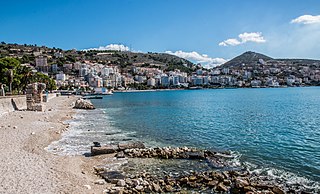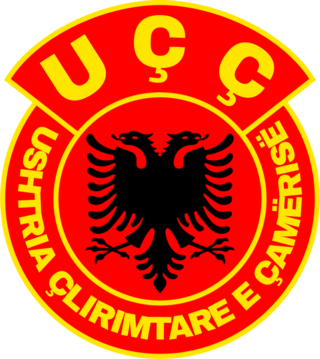Тимфея
Тимфея или Тимфайя (греч. Τυμφαία) — древнегреческая область, расположенная в регионе Эпир, населённая темфеями, северо-западным греческим племенем, принадлежавшем к молосцам[1][2]. Область была аннексирована и стала провинцией Македонии в IV веке до нашей эры[3].
История
В связи с тем, что греческие топонимы, очень часто встречаются на более широкой территории, предполагается, что носители протогреческого языка населяли регион, который включал Тимфею, до миграций позднего бронзового века (конец 3-го — начало 2-го тысячелетия до нашей эры) в течение нескольких столетий или даже тысячелетий до этого[4]. Тимфея была названа в честь горы Тимфи[5][6]. Примерно в 350 году до нашей эры Тимфея была завоевана Филиппом II Македонским и включена в состав Македонии как часть Верхней Македонии[3][7].
Тимфеи, населявшие эту область, принадлежали к более широкому племени молосцов[1]. Они были одним из эпиротских племён северо-западной греческой группы[8]. Они поклонялись Зевсу, которого называли Дейпатурос, вероятно, как богу своей горы Тимфи[9].
Города
Существует не так много письменных свидетельств о древних городах этой области. В текстах историка Диодора Сицилийского упоминается город Трампия[англ.], в котором в эллинистический период произошла битва между Полиперхоном и Кассандром по поводу наследования Македонии Гераклом, незаконнорождённым сыном Александра Македонского[10]. Соседний город Вунима[англ.] упоминается Стефаном Византийским, как основанный Одиссеем[11]. Страбон отнёс к Тимфее город Эгинион[англ.][12].
Известные уроженцы
Самым известным уроженцем Тимфеи был Полиперхон, полководец Александра Македонского. Он был сыном Симмия, который был правителем Тимфеи[13].
Примечания
- ↑ 1 2 Hammond, 1982, p. 276: «As we leave the coastal area, we may turn first to the middle and upper Haliacmon valley, where Elimeotis, Tymphaea and Orestis were inhabited by Epirotic tribes, or more correctly 'Molossian' tribes if the account in Strabo was derived from Hecataeus.».
- ↑ Hammond, 1993, pp. 132—133: «Further, the tribes which Strabo termed "Epirotic" — Orestai, Tymphaioi, Elimiotai, Lynkestai and Pelagones — are likely to have spoken the same dialect as the Molossians, to whom they were in some sense related.».
- ↑ 1 2 Hammond, 1994, p. 206: «When Philip annexed Elimea, Orestis, and Lyncus and territory up to Lake Lychnitis, reorganized the administration, and planted towns such as Heraclea Lyncestis, he was in a position to recruit and train infantry from these areas, ready for service perhaps by 352 B.C.; and similarly from Tymphaea, annexed probably in 350 B.C., infantry ready for service by 345 B.C.».
- ↑ Georgiev, 1973, p. 247: «The region north of this line, which comprises Epirus as far as Aulon, in the north (including Paravaia, Tymphaea, Athamania, Dolopia, Amphilochia and Acarnania), western and northern Thessaly (Hestiaeotis, Perrhaebia, Tripolis) and Pieria, i.e. approximately the whole of northern and north-western Greece, is characterized by the following features. 1. Absence of pre-Hellenic place-names. [...] All the principal names north of the line are of archaic Greek origin. [...] Thus in the region defined just above, roughly northern and northwestern Greece. [...] Since Greek place-names are very dense in that region and they have a very archaic appearance, one may suppose that the proto-Greeks were settled in it during many centuries and even millennia.».
- ↑ Hammond, 1993, p. 141: «We see here the origins of the Tymphaioi (named after Mt. Tymphe) Orestai, Lynkestai and Pelagones, who practiced this way of life and were each a cluster of tribes.».
- ↑ Hammond, 1993, p. 143: «... the "Tymphaioi" were so named from the mountain Tymphe.».
- ↑ Hatzopoulos, 1996, p. 249: «Hatzopoulos 1996, p. 249: "Finally, the fourth meris gathered the Upper Macedonian ethne (Lynkestai, Tymphaioi, Atintanes), to which Pelagonia (presumably with Derriopos), in other words the western part of the former strategia of Paionia, was added/».
- ↑ Hammond, 1967, p. 538.
- ↑ Hammond, 2000, p. 6.
- ↑ A geographical and historical description of ancient Greece : [англ.]. — 2013. — Vol. 1. — P. 144. — ISBN 978-5-5186-4044-3.
- ↑ An Inventory of Archaic and Classical Poleis: An Investigation Conducted by The Copenhagen Polis Centre for the Danish National Research Foundation : [англ.]. — Oxford University Press, 2005. — P. 339. — ISBN 978-0-1981-4099-3.
- ↑ Страбон. Глава 7, секция 9 // География = Γεογραφικά (греч.). — А. Мейнеке. — Лейпциг, 1877. — Т. 7.
- ↑ Pleket, Stroud, Strubbe, 1994, p. 124: «Polyperchon, one of Alexander's generals and later regent (319 B.C.), son of Simmias who ruled the Tymphaioi ca. 370 B.C.».
Литература
- Benveniste, Émile. Dictionary of Indo-European Concepts and Society : [англ.]. — Chicago, IL : Hau Books (University of Chicago Press), 2016. — ISBN 978-0-9861325-9-9.
- Georgiev, Vladimir I. The Arrival of the Greeks in Greece: The Linguistic Evidence // Bronze Age Migrations in the Aegean; Archaeological and Linguistic Problems in Greek Prehistory: Proceedings of the First International Colloquium on Aegean Prehistory, Sheffield : [англ.]. — London : Gerald Duckworth & Company Limited, 1973. — P. 243–253. — ISBN 978-0-7156-0580-6.
- Hammond, Nicholas (2000). "The Ethne in Epirus and Upper Macedonia". The Annual of the British School at Athens (англ.). 95: 345—352. doi:10.1017/S0068245400004718. JSTOR 30103439. S2CID 140559037.
- Hammond, Nicholas Geoffrey Lemprière. Collected Studies : [англ.]. — Amsterdam : Hakkert, 1994. — Vol. III.
- Hammond, Nicholas Geoffrey Lemprière. Epirus: The Geography, the Ancient Remains, the History and the Topography of Epirus and Adjacent Areas : [англ.]. — Oxford : The Clarendon Press, 1967.
- Hammond, Nicholas Geoffrey Lemprière. Studies Concerning Epirus and Macedonia Before Alexander : [англ.]. — Amsterdam : Hakkert, 1993. — ISBN 978-9-0256-1050-0.
- Hammond, Nicholas Geoffrey Lemprière. CHAPTER 40 ILLYRIS, EPIRUS AND MACEDONIA // The Cambridge Ancient History: The Expansion of the Greek World, Eighth to Sixth Centuries B.C. : [англ.]. — 2nd. — Cambridge : Cambridge University Press, 1982. — Vol. III, Part 3. — P. 261–285. — ISBN 0-521-23447-6.
- Hatzopoulos, Miltiades V. Macedonian Institutions Under the Kings: A Historical and Epigraphic Study, Volume 1 : [англ.]. — Athens : Kentron Hellēnikēs kai Rōmaïkēs Archaiotētos, 1996. — ISBN 978-9-6070-9490-2.
- Pleket, H. W. Supplementum Epigraphicum Graecum, Volumes 44–45 : [англ.] / H. W. Pleket, R. S. Stroud, Johan Strubbe. — Amsterdam : J.C. Gieben, 1994. — ISBN 978-9-0506-3528-8.












